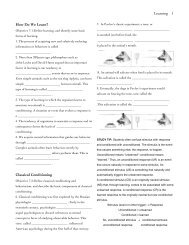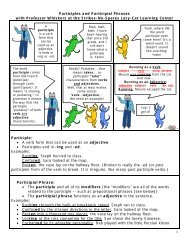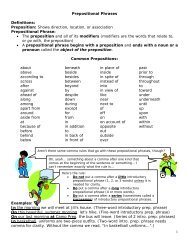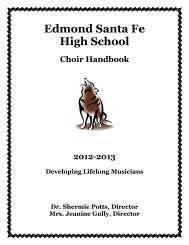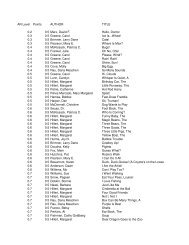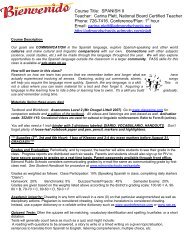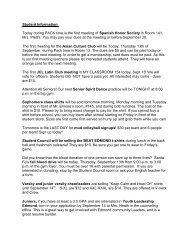ARCHETYPE DEFINITIONS - Edmond Public Schools
ARCHETYPE DEFINITIONS - Edmond Public Schools
ARCHETYPE DEFINITIONS - Edmond Public Schools
Create successful ePaper yourself
Turn your PDF publications into a flip-book with our unique Google optimized e-Paper software.
<strong>ARCHETYPE</strong><br />
<strong>DEFINITIONS</strong><br />
SITUATION <strong>ARCHETYPE</strong>S<br />
1. The Quest-This motif describes the search for someone or some<br />
talisman which, when found and brought back, will restore fertility to a<br />
wasted land, the desolation of which is mirrored by a leader's illness and<br />
disability.<br />
2. The Task-This refers to what possibly superhuman feat must be accomplished in order to fulfill the<br />
ultimate goal.<br />
3. The Journey-The journey sends the hero in search for some truth of information necessary to restore<br />
fertility, justice, and/or harmony to the kingdom. The journey includes the series of trials and tribulations the<br />
hero faces along the way. Usually the hero descends into a real or psychological hell and is forced to<br />
discover the blackest truths, quite often concerning his faults. Once the hero is at this lowest level , he must<br />
accept personal responsibility to return to the world of the living.<br />
4. The Initiation-This situation refers to a moment, usually psychological, in which an individual comes<br />
into maturity. He or she gains a new awareness into the nature of circumstances and problems and<br />
understands his or her responsibility for trying to resolve the dilemma. Typically, a hero receives a Calling,<br />
a message or signal that he or she must make sacrifices and become responsible for "getting involved" in<br />
the problem. Often a hero will deny and question the calling and ultimately, in The Initiation, will accept<br />
responsibility.<br />
5. The Ritual-Not to be confused with The Initiation, The Ritual refers to an organized ceremony which<br />
involves honored members of a given community and an Initiate. This situation officially brings the young<br />
man or woman into the realm of the community's adult world.<br />
6. The Fall-Not to be confused with the awareness in The Initiation, this archetype describes a descent in<br />
action from a higher to a lower state of being, an experience which might involve defilement, moral<br />
imperfection, and/or loss of innocence. This fall is often accompanied by expulsion from a kind of paradise<br />
as penalty for disobedience and/or moral transgression.<br />
7. Death and Rebirth-The most common of all situational archetypes, this motif grows out of the parallel<br />
between the cycle of nature and the cycle of life. It refers to those situations in which someone or<br />
something, concrete and/or metaphysical dies, yet is accompanied by some sign of birth or rebirth.<br />
8. Nature vs. Mechanistic World-Expressed in its simplest form, this refers to situations which suggest<br />
that nature is good whereas the forces of technology are bad.<br />
9. Battle Between Good and Evil-These situations pit obvious forces which represent good and evil against<br />
one another. Typically, good ultimately triumphs over evil despite great odds.<br />
10. The Unhealable Wound-This wound, physical or psychological, cannot be healed fully. This would<br />
also indicates a loss of innocence or purity. Often these wounds' pain drives the sufferer to desperate<br />
measures of madness.<br />
11. The Magic Weapon-Sometimes connected with the Task, this refers to a skilled individual hero's<br />
ability to use a piece of technology in order to combat evil, continue a journey, or to prove his or her<br />
identity as a chosen individual.
SYMBOLIC <strong>ARCHETYPE</strong>S<br />
1. Light vs. Darkness-Light usually suggests hope, renewal, OR intellectual illumination; darkness<br />
implies the unknown, ignorance, or despair.<br />
2. Water vs. Desert-Because water is necessary to life and growth, it commonly appears as a birth or rebirth<br />
symbol. Water is used in baptism services, which solemnizes spiritual births. Similarly, the appearance of<br />
rain in a work of literature can suggest a character's spiritual birth.<br />
3. Heaven vs. Hell-Humanity has traditionally associated parts of the universe not accessible to it with the<br />
dwelling places of the primordial forces that govern its world. The skies and mountain tops house its gods;<br />
the bowels of the earth contain the diabolic forces that inhabit its universe.<br />
4. Haven vs. Wilderness-Places of safety contrast sharply against the dangerous wilderness. Heroes<br />
are often sheltered for a time to regain health and resources.<br />
5. Supernatural Intervention-The gods intervene on the side of the hero or sometimes against him.<br />
6. Fire vs. Ice-Fire represents knowledge, light, life, and rebirth while ice like desert represents<br />
ignorance, darkness, sterility, and death<br />
CHARACTER <strong>ARCHETYPE</strong>S<br />
1. The Hero-In its simplest form, this character is the one ultimately who may fulfill a necessary task and<br />
who will restore fertility, harmony, and/or justice to a community. The hero character is the one who<br />
typically experiences an initiation, who goes the community's ritual (s), et cetera. Often he or she will<br />
embody characteristics of YOUNG PERSON FROM THE PROVINCES, INITIATE, INNATE WISDOM,<br />
PUPIL, and SON.<br />
2. Young Person from the Provinces-This hero is taken away as an infant or youth and raised by strangers.<br />
He or she later returns home as a stranger and able to recognize new problems and new solutions.<br />
3. The Initiates-These are young heroes who, prior to the quest, must endure some training and ritual.<br />
They are usually innocent at this stage.<br />
4. Mentors-These individuals serve as teachers or counselors to the initiates. Sometimes they work as<br />
role models and often serve as father or mother figure. They teach by example the skills necessary to<br />
survive the journey and quest.<br />
5. Father-Son Conflict-Tension often results from separation during childhood or from an external source<br />
when the individuals meet as men and where the mentor often has a higher place in the affections of the<br />
hero than the natural parent. Sometimes the conflict is resolved in an atonement.<br />
6. Hunting Group of Companions-These loyal companions are willing to face any number of perils in<br />
order to be together.<br />
7. Loyal Retainers-These individuals are like the noble sidekicks to the hero. Their duty is to protect<br />
the hero. Often the retainer reflects the hero's nobility.<br />
8. Friendly Beast-These animals assist the hero and reflect that nature is on the hero's side.<br />
9. The Devil Figure-This character represents evil incarnate. He or she may offer worldly goods, fame, or<br />
knowledge to the protagonist in exchange for possession of the soul or integrity. This figure's main aim is<br />
to oppose the hero in his or her quest.<br />
10. The Evil Figure with the Ultimately Good Heart-This redeemable devil figure-or servant to the devil<br />
figure-is saved by the hero's nobility or good heart.
11. The Scapegoat-An animal or more usually a human whose death, often in a public ceremony, expiates<br />
some taint or sin that has been visited upon the community.<br />
12. Innate Wisdom vs. Educated Stupidity-Some characters exhibit wisdom and understanding<br />
intuitively as opposed to those supposedly in charge.<br />
13. The Outcast-This figure is banished from a community for some crime (real or imagined). The outcast<br />
is usually destined to become a wanderer.<br />
14. The Earthmother-This character is symbolic of fruition, abundance, and fertility, offer spiritual and<br />
emotional nourishment to those who she contacts; often depicted in earth colors, with large breasts and hips.<br />
15. The Temptress-Characterized by sensuous beauty, she is one whose physical attraction may bring<br />
about the hero's downfall.<br />
16. The Platonic Ideal-This source of inspiration often is a physical and spiritual ideal for whom the hero<br />
has an intellectual rather than physical attraction.<br />
17. The Unfaithful Wife-This woman, married to a man she sees as dull or distant, is attracted to a more<br />
virile or interesting man.<br />
18. The Damsel in Distress-This vulnerable woman must be rescued by the hero. She also may be used as<br />
a trap, by an evil figure, to ensnare the hero.<br />
19. The Star-Crossed Lovers-These two characters are engaged in a love affair that is fated to end in<br />
tragedy for one or both due to the disapproval of society, friends, family, or the gods.<br />
20. The Creature of Nightmare-This monster, physical or abstract, is summoned from the deepest,<br />
darkest parts of the human psyche to threaten the lives of the hero/heroine. Often it is a perversion or<br />
desecration of the human body.



